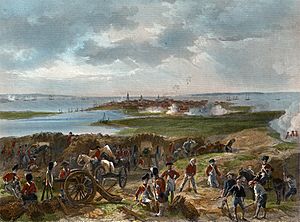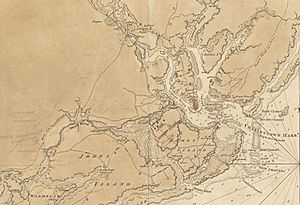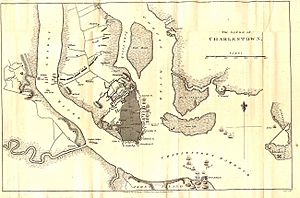Siege of Charleston facts for kids
Quick facts for kids Siege of Charleston |
|||||||
|---|---|---|---|---|---|---|---|
| Part of the American Revolutionary War | |||||||
 Siege of Charleston 1780 by Alonzo Chappel |
|||||||
|
|||||||
| Belligerents | |||||||
|
|||||||
| Commanders and leaders | |||||||
|
|
|
||||||
| Strength | |||||||
| 12,847 regulars and militia 4,500 sailors 6 ships of the line 8 frigates 4 armed galleys 90 transports |
6,577 regulars, sailors and militia 3 frigates 5 sloops 1 schooner 1 brig 3 armed galleys |
||||||
| Casualties and losses | |||||||
| 76 killed, 189 wounded |
89 killed, 138 wounded 5,466 captured All ships captured |
||||||
The Siege of Charleston was a major battle during the American Revolutionary War. It took place in Charles Town (now Charleston), the capital of South Carolina. The siege lasted from March 29 to May 12, 1780.
During this time, British forces surrounded the city. After about six weeks, Major General Benjamin Lincoln, who led the American troops in Charleston, had to surrender. This was a huge victory for the British. It was also one of the worst defeats for the American side during the entire war.
Contents
Why the British Attacked Charleston
By late 1779, the British had faced some big challenges in the northern parts of America. Their plan to invade from Canada failed when General John Burgoyne surrendered at the Battle of Saratoga. This defeat encouraged both France and Spain to join the war against Great Britain.
The British also tried to capture Philadelphia, the American capital at the time. This effort had limited success. So, Sir Henry Clinton, the British Commander-in-Chief, decided to change his strategy. He moved his forces back to New York City.
The British then decided to focus on the southern colonies. This was called their "Southern Strategy." They believed many people in the South, called Loyalists, would support them. Loyalists were colonists who wanted to remain loyal to the British King. The British thought these Loyalists would rise up against the American Patriots.
The British started their Southern Strategy by capturing Savannah, Georgia in December 1778. After successfully defending Savannah from a combined French and American attack in October 1779, the British planned to capture Charleston. They wanted to use Charleston as a main base for their operations in the South.
The British Advance to Charleston
Sir Henry Clinton left Newport, Rhode Island in October 1779. He also left a large group of soldiers in New York City. In December 1779, Clinton and his second-in-command, Charles Cornwallis, sailed south. They had 8,500 soldiers and 5,000 sailors on 90 transport ships and 14 warships.
Their journey was very stormy. The fleet finally arrived in the Savannah River on February 1, 1780. By February 12, Clinton's army had landed on Simmons Island, about 30 miles south of Charleston.
The British continued to move closer to the city. By March 10, Lord Cornwallis had reached the mainland. On March 29, 1780, they crossed the Ashley River. This brought them right to Charleston.
During this time, Clinton had promised freedom to enslaved people who escaped from American rebels and helped the British. Many enslaved people, known as Black Loyalists, left the Charleston area to join the British.
The Siege Begins
On April 1, the British began their siege. They were about 800 yards from the American defenses. These defenses were located near what is now Marion Square.
To protect the harbor, American Commodore Abraham Whipple decided to sink his own ships at the mouth of the Cooper River. This was done to block the British navy. However, on April 8, British Admiral Mariot Arbuthnot successfully brought his 14 ships into the harbor. They sailed past the guns of Fort Moultrie. On the same day, 750 American soldiers from Virginia arrived to help defend Charleston.
To fully surround the city, Clinton sent Banastre Tarleton and Patrick Ferguson to capture Monck's Corner on April 14. This cut off Charleston from any outside help. On April 18, Lt. Col. Lord Rawdon arrived with 2,500 more British soldiers. These included the 42nd Highlanders and Hessian troops. Charleston was now completely surrounded.
Attempts to Surrender and Final Fall
Governor John Rutledge managed to escape from Charleston on April 13. On April 21, the American commander, Benjamin Lincoln, asked to surrender with "honours of war." This meant his troops would be allowed to march out with their flags and weapons. However, Clinton refused this offer.
On April 23, Lord Cornwallis crossed the Cooper River. He joined other British troops, blocking any further escape routes from the city. On April 25, some Charleston citizens, led by Christopher Gadsden, stopped Lincoln from trying to move his troops out of the city.
On May 6, Tarleton won another battle at Battle of Lenud's Ferry. Meanwhile, the British siege works had moved very close to Charleston's defenses. They even managed to drain the canal in front of the city's walls.
On May 7, Fort Moultrie surrendered without a fight. On May 8, Clinton demanded Lincoln's unconditional surrender. Lincoln tried again to negotiate for the honours of war. But on May 11, Gadsden and other citizens urged Lincoln to surrender. That same day, the British fired heated shot into the city, causing several homes to burn. Lincoln felt he had no choice but to negotiate terms for surrender.
On May 12, Lincoln officially surrendered 3,371 men to the British. When news of Charleston's fall reached other American troops in the backcountry, those holding Ninety-Six and Camden also surrendered.
After the Siege
The British captured a huge amount of supplies and prisoners. They took about 5,266 prisoners, 311 cannons, 9,178 cannonballs, 5,916 muskets, and 33,000 rounds of ammunition. They also captured 15 regimental flags, 49 ships, 120 boats, and large amounts of food and other goods.
After the surrender, the captured weapons were brought to a powder magazine. A Hessian officer warned that some guns might still be loaded, but he was ignored. One gun fired by accident, causing 180 barrels of gunpowder to explode. This explosion also set off 5,000 muskets in the magazine. About 200 people died in this accident, and six houses were destroyed.
The American prisoners were sent to different places, including prison ships. Many of the Continental soldiers were held on these ships. Militia members and civilians were often released if they promised not to fight against the British again. This defeat greatly weakened the American army in the South.
The surrender of Charleston was a major setback for the American cause. It was the largest surrender of an American force until the American Civil War. After this defeat, there was no large American army left in the South, making it easier for the British to advance.
When the Americans surrendered, they were not given the "honours of war." Later, during the Siege of Yorktown, General George Washington refused to give the British the same honours when they surrendered to him. He said, "The same Honors will be granted to the Surrendering Army as were granted to the Garrison of Charles Town."
On June 5, Clinton sailed back to New York City. He thought he was needed there to defend against a possible French and American attack. He left Lord Cornwallis in charge of the southern war. Cornwallis was ordered to defeat any remaining American resistance in North Carolina.
However, the British strategy soon faced problems. The expected large uprising of Loyalists did not happen. This made it hard for the British to control the countryside. Instead, the fighting in South Carolina turned into chaotic guerrilla warfare in the outer areas.
Forces Involved in the Siege
The British and American forces involved in the Siege of Charleston were made up of many different units.
British Forces
The British forces were led by Sir Henry Clinton. His second-in-command was Lord Cornwallis. The British regular soldiers were led by Brigadier General Alexander Leslie.
The British army included:
- Many regiments of foot (infantry), including light infantry and grenadier companies.
- Hessian soldiers, who were German troops hired by the British.
- Loyalist regiments, made up of Americans who supported the British.
- Artillery units with cannons.
- Cavalry units, like the 17th Light Dragoons.
- Engineers and pioneers, who helped build fortifications.
The British naval forces were commanded by Mariot Arbuthnot. They included:
- Several large warships, like HMS Europa and HMS Roebuck.
- Smaller armed ships and galleys.
- About 90 transport ships to carry troops and supplies.
American and French Forces
The American and French forces defending Charleston were led by Benjamin Lincoln. The American Continental Army troops were led by Brigadier General William Moultrie.
The American and French forces included:
- Continental Army regiments from South Carolina, North Carolina, and Virginia.
- Militia units from various South Carolina and North Carolina districts. These were local citizens who served as soldiers.
- Artillery units with cannons.
- Engineers.
- Cavalry units.
- A company of French soldiers from Saint-Domingue (Haiti).
The naval forces defending the city were led by American Commodore Abraham Whipple. They included:
- Ships from the Continental Navy, such as USS Ranger and USS Providence.
- Ships from the South Carolina state navy.
- A few ships from the French Navy.
Images for kids
See also
 In Spanish: Asedio de Charleston para niños
In Spanish: Asedio de Charleston para niños





